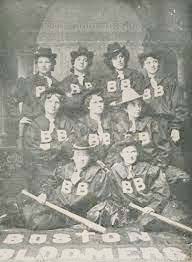By William “Skip” Deegans
In the late 1800s, women couldn’t vote and couldn’t own property after marriage, but they could play baseball. The first women’s baseball teams started at Vassar and other women’s colleges in 1863. The players wore long skirts, high necks and long sleeves. At the high school level, girls at Connecticut’s Miss Porter’s School could play as long as the fields were outside public view.
In the 1890s, women’s professional teams called Bloomer Girls were organized. They were so named for their uniforms that consisted of loose fitting pants that gathered at the knees and had been designed by Amelia Bloomer to enable women to better ride bicycles. Most of the teams had men pitchers and sometimes male catchers – called “toppers.” They wore curly wigs and dresses. The Bloomer Girls criss-crossed the country playing men’s teams that they beat more often than not. Although the teams were not integrated, there were African American Bloomer Girls who would, on occasion, play the white teams. The Boston Bloomer Girls (shown in this undated photo) traveled to their games in a private Pullman railroad car. One of the New York players recorded that she earned between $5 and $20 a game.
While the games were very popular and sometimes broke attendance records at ballfields, the women were not always so well received. When the Boston Bloomer Girls played the local men’s team in Clarksburg, WV, in 1901, local constables arrived in the ninth inning, loaded the women in a patrol wagon, and took them to jail for playing a game on the Sabbath. The opposing players were served with writs to appear in court. The press pointed out that saloons and gambling joints openly defied Sunday laws and were not molested. After the manager agreed to pay a fine of $5 for each player, the team was released.
By the 1930s, interest in the Bloomer Girls waned, but it wasn’t the end of women’s baseball. In an effort to keep baseball alive during World War II when men were unavailable, the All-American Girls Professional League was organized in the Midwest with teams like the Rockford Peaches, Racine Belles and Kenosha Comets. Over 600 women played on 10 teams from 1943 to 1954.
Photo from the Massachusetts Historical Society.
Sources: Massachusetts Historical Society, National Baseball Hall of Fame, Prairie Public Broadcasting, The Clarksburg Telegram, The West Virginia News.




